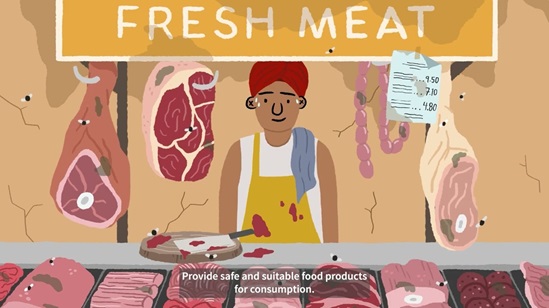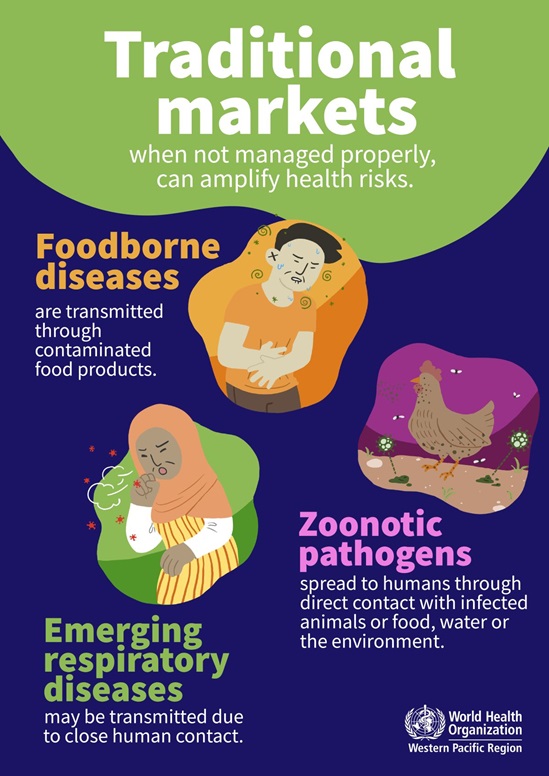Food safety
Access to safe and healthy food is key to sustaining life and promoting good health. However, unsafe food containing harmful bacteria, viruses, parasites or chemical substances can cause more than 200 diseases – ranging from diarrhoea to cancers. Examples of unsafe food include uncooked foods of animal origin, fruits and vegetables contaminated with pesticides and faeces, and raw shellfish containing marine biotoxins.
More than 50 000 people die every year in the Western Pacific Region from consuming unsafe food and another 125 million fall ill from unsafe food. Each year, 30% of cases of foodborne illness are in children under age 5 and an estimated 7000 children die as a result.
Diarrhoeal disease agents are the main cause of foodborne illness; the most common disease-causing agents are norovirus, non-typhoidal salmonella and campylobacter, accounting for nearly 45% of all foodborne illnesses. However, Aflatoxins are responsible for many foodborne deaths in the Region.
Foodborne diseases impede socioeconomic development by straining health care systems and harming national economies, tourism and trade. The burden of foodborne diseases to public health and to economies has often been underestimated due to underreporting and difficulty to establish causal relationships between food contamination and resulting illness or death. Children aged 5 and under carry 40% of the foodborne disease burden, with 125 000 deaths every year.
The consumption and production of safe food have immediate and long-term benefits for people, the planet and the economy. Safe food is essential to human health and well-being, only food that is safe can be traded. Safe food allows for the uptake of nutrients and promotes long-term human development.
The 2019 World Bank report on the economic burden of foodborne diseases indicated that US$ 110 billion is lost each year in productivity and medical expenses resulting from unsafe food in low- and middle-income countries. Unsafe or contaminated food leads to trade rejections, economic losses and food loss and waste, while safe food production improves economic opportunities by enabling market access and productivity.
WHO provides regional leadership to facilitate investment and coordinated evidence-based action across multiple sectors. WHO supports Member States to build strong, sustainable and resilient national food control systems with a balance of responsibilities between different stakeholders, including consumers. WHO also calls for the transformation of food systems to make food safe, healthy and sustainably produced for all the world population.
The Asia Pacific Health Security Action Framework (APHSAF) supports the objectives of global and regional strategies for food safety, including the WHO Global Strategy for Food Safety 2022-2030 and the Regional Framework for Action on Food Safety in the Western Pacific through strengthening capacities to detect, assess and manage foodborne disease outbreaks and One Health collaborations with animal, environment and food-production sectors.
The Regional Framework for Action on Food Safety in the Western Pacific approved in 2017 has a timeframe for implementation of 2018-2025. It is intended to guide Member States on strategic actions and a stepwise approach to strengthen food safety systems to better manage food safety risks and respond to food safety incidents and emergencies, contributing to the Region’s health security.
WHO enables resilient food safety systems through:
- providing scientific advice and research to help develop international standards for food safety through the Food and Agriculture Organization (FAO)/WHO Codex Alimentarius,
- monitoring the global burden of foodborne diseases and supporting countries in burden estimates,
- ensuring stronger national food control systems by comprehensive assessments through the FAO/WHO food control system assessment tool, and
- implementing adequate infrastructure to respond to food safety emergencies through the International Food Safety Authorities Network (INFOSAN).











/avian-influenza--what-you-need-to-knowac92cf15-fc6e-4ecd-83f9-02968666e01c.tmb-549v.png?sfvrsn=bf0f159f_1)
/avian-influenza--preparing-food-safely.tmb-549v.png?sfvrsn=f081c874_1)
/common-symptoms-of-influenza.tmb-549v.png?sfvrsn=5213bc99_1)
